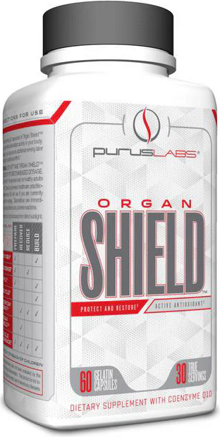
Purus Labs Organ Shield
Go to Store| Serving Size: 2 Capsules | ||
| Servings Per Container: 30 | ||
| Amount Per Serving | % DV * | |
| Milk Thistle (standarized for 80% silymarin) | 300mg | ** |
| Beta-Sitosterol (Pygeum africnum) | 250mg | ** |
| Saw Palmetto (Serenoa Repens) (berries) | 200mg | ** |
| N-Acetyl-L-Cysteine (NAC) | 250mg | ** |
| Alpha Lipoic Acid (ALA) | 150mg | ** |
| Quercitin Dihydrate | 150mg | ** |
| Coenzyme Q-10 (CoQ10) (trans-isomer) | 100mg | ** |
|
* % Daily Value (DV) is based on a 2,000 calorie diet. Your daily values may be higher or lower based on your calorie needs.
† Daily Value (DV) not established. |
||
|
Other Ingredients: none |
||

Purus Labs Organ Shield
Go to StorePurus Labs maintains its focus on bringing you safe, anabolism-inducing product stacks by engineering the most pivotal protection compliment to any “pro-anabolic” cycle. Organ Shield was specifically designed to support, protect, and restore hepatic (liver), prostatic (prostate), and cardiovascular (heart) function during times of high stress, such as when using “pro-anabolics.” This blend of specific antioxidants, flavanoids, and phytonutrients scavenges free radicals preventing them from attacking healthy cells as well repairing damaged cells. 365 days a year, whether ON-cycle or OFF-cycle, this is a must for any serious athletes’ arsenal!
Milk Thistle
The antioxidant milk thistle has been used since Greco-Roman times to treat an array of liver ailments. Several studies suggest milk thistle protects the liver from damaging toxins such as alcohol and certain drugs. The active component most responsible for milk thistle’s detoxifying effects is called silymarin. This substance, comprised of several flavonolignands, helps repair liver cells damaged by toxins as well as protecting healthy liver cells. It has also been purported to have cholesterol lowering benefits as well.
N-Acetyl-L-Cysteine (NAC)
NAC, arguably the pinnacle antioxidant, consists of the amino acid cysteine joined with an acetyl group making it more soluble and more biovailable than L-Cysteine alone. NAC , basically a precursor to glutathione, donates cystiene to form glutathione which is found in the body and produced in the liver. NAC has been shown in studies to prevent cell death.
Alpha Lipoic Acid (ALA)
Alpha Lipoic Acid is quite possibly the most novel, multifaceted, and important antioxidants available today. It neutralizes free radicals in both the aqueous and lipid portions of cells, is a key player in the synergism of other antioxidants extending the metabolic life of glutathione and Coenzyme Q-10, repairs liver damage, has blood lipid modulating properties lowering risk factors associated with cardiovascular disease (CVD), and enhances insulin function speeding the removal of glucose from the bloodstream and ushering it into muscles.
Beta-Sitosterol
Beta-Sitosterol is one of many phytosterols, phytochemicals naturally occurring in plants, whose structure closely resembles cholesterol. It has been shown to significantly lower cholesterol and has been used to treat hypercholesterolemia. Its major mechanisms of action are thought to be by preventing the absorption of dietary fat in the intestines where fat is digested and by increasing the flow of cholesterol binding bile acids in the digestive track excreting it in the feces. Beta-Sitosterol has also been proven effective in many studies in treating BPH (benign prostatic hypertrophy).
Saw Palmetto
Rich in phytosterols and fatty acids, Saw Palmetto has been used in treating BPH as well as male pattern baldness. This is largely due to its supposed ability to inhibit 5-alpha reductase, an enzyme responsible for converting precious testosterone into DHT, and interfering with DHT’s binding ability to androgen receptors.
Quercetin
A highly active flavonoid, Quercitin, is yet another fierce antioxidant scavenging free radicals within the body. It most notably improves cardiovascular function by preventing the oxidation of LDL thus lowering cholesterol, lowering blood pressure, and also possesses anti-inflammatory properties.
Coenzyme Q-10 (CoQ-10)
CoQ-10 is a fat soluble, vitamin like antioxidant found in cells. The biosynthesis of CoQ-10 requires 8 other vitamins and several trace enzymes. It serves as the coenzyme for mitochondrial enzymes involved in the synthesis of ATP, which all cellular function depends. It is highly concentrated in the heart due to the high energy requirements of this muscle and has been studied due to the link between people with congestive heart failure and their corresponding low levels of CoQ-10. It also aids in healthy cholesterol levels because it inhibits the oxidation of LDL.
Research:
- Randi L. Edwards, Tiffany Lyon, Sheldon E. Litwin, Alexander Rabovsky, J. David Symons, Thunder Jalili. Quercetin Reduces Blood Pressure in Hypertensive Subjects. J. Nutr. 137:2405-2411, November 2007
- Lin LY, Peng CC, Yang YL, Peng RY. Optimization of bioactive compounds in buckwheat sprouts and their effect on blood cholesterol in hamsters. J Agric Food Chem. 2008 Feb 27;56(4):1216-23. Epub 2008 Jan 24.
- Juzwiak S, Wójcicki J, Mokrzycki K, Marchlewicz M, Bialecka M, Wenda-Rózewicka L, Gawronska-Szklarz B, Drozdzik M. Effect of Quercetin on experimental hyperlipidemia and atherosclerosis in rabbits. Pharmacol Rep. 2005 Sep-Oct;57(5):604-9.
- Zern TL, Wood RJ, Greene C, West KL, Liu Y, Aggarwal D, Shachter NS, Fernandez ML. Grape polyphenols exert a cardioprotective effect in pre and postmenopausal women by lowering plasma lipids and reducing oxidative stress. J Nutr. 2005 Aug;135(8):1911-7.
- U. Cornelli, R. Terranova, S. Luca, M. Cornelli, and A. Alberti Bioavailability and Antioxidant Activity of Some Food Supplements in Men and Women Using the D-Roms Test as a Marker of Oxidative Stress J. Nutr. 2001 131: 3208-3211.
- Singh RB, Niaz MA, Rastogi V, Rastogi SS. Coenzyme Q-10 in cardiovascular disease. J Assoc Physicians India. 1998 Mar;46(3):299-306.
- Sinatra ST, DeMarco J. Free radicals, oxidative stress, oxidized low density lipoprotein (LDL), and the heart: antioxidants and other strategies to limit cardiovascular damage. Conn Med. 1995 Oct;59(10):579-88.
- Asghar Z, Masood Z. Evaluation of antioxidant properties of silymarin and its potential to inhibit peroxyl radicals in vitro. Pak J Pharm Sci. 2008 Jul;21(3):249-54.
- Tamayo C, Diamond S. Review of clinical trials evaluating safety and efficacy of milk thistle. Integr Cancer Ther. 2007 Jun;6(2):146-57.
- Guler G, Turkozer Z, Tomruk A, Seyhan N. The protective effects of N-acetyl-L-cysteine epigallocatechin-3-galate on electric field-induced hepatic oxidative stress. Int J Radiat Biol. 2008 Aug;84(8):669-80
- Mansour HH, Hafez HF, Fahmy NM, Hanafi N. Protective effect of N-acetylcysteine against radiation induced DNA damage and hepatic toxicity in rats. Biochem Pharmacol. 2008 Feb 1;75(3):773-80. Epub 2007 Sep 25.
- Kortsalioudaki C, Taylor RM, Cheeseman P, Bansal S, Mieli-Vergani G, Dhawan A. Safety and efficacy of N-acetylcysteine in children with non-acetaminophen-induced acute liver failure. Liver Transpl. 2008 Jan;14(1):25-30.
- Habib FK, Ross M, Ho CK, Lyons V, Chapman K. Serenoa repens (Permixon) inhibits the 5alpha-reductase activity of human prostate cancer cell lines without interfering with PSA expression. Int J Cancer. 2005 Mar 20;114(2):190-4.
- Prager N, Bickett K, French N, Marcovici G. A randomized, double-blind placebo-controlled trial to determine the effectiveness of botanically derived inhibitors of 5-alpha-reductase in the treatment of androgenic alopecia. J Altern Complement Med. 2002 Apr;8(2):143-52.
- J. M. R. Beveridge, H. L. Haust, and W. Ford Connell Magnitude of the Hypocholesterolemic Effect of Dietary Sitosterol in Man J. Nutr. 1964 83: 119-122.
- D. W. Peterson, E. A. Shneour, N. F. Peek, and H. W. Gaffey Dietary Constituents Affecting Plasma and Liver Cholesterol in Cholesterol-Fed Chicks J. Nutr. 1953 50: 191-201.
- Stephanie D. Wollin and Peter J. H. Jones -Lipoic Acid and Cardiovascular Disease J. Nutr. 2003 133: 3327-3330.
- Ghibu S, Richard C, Delemasure S, Vergely C, Mogosan C, Muresan A. An endogenous dithiol with antioxidant properties: alpha-lipoic acid, potential uses in cardiovascular diseases. Ann Cardiol Angeiol (Paris). 2008 Jun;57(3):161-5. Epub 2008 Jun 4.
- Lal A, Atamna W, Killilea DW, Suh JH, Ames BN. Lipoic acid and acetyl-carnitine reverse iron-induced oxidative stress in human fibroblasts. Redox Rep. 2008;13(1):2-10.
- Park KG, Min AK, Koh EH, Kim HS, Kim MO, Park HS, Kim YD, Yoon TS, Jang BK, Hwang JS, Kim JB, Choi HS, Park JY, Lee IK, Lee KU. Alpha-lipoic acid decreases hepatic lipogenesis through adenosine monophosphate-activated protein kinase (AMPK)-dependent and AMPK-independent pathways. Hepatology. 2008 Nov;48(5):1477-86.
- Jariwalla RJ, Lalezari J, Cenko D, Mansour SE, Kumar A, Gangapurkar B, Nakamura D. Restoration of blood total glutathione status and lymphocyte function following alpha-lipoic acid supplementation in patients with HIV infection. J Altern Complement Med. 2008 Mar;14(2):139-46.






